What’s in my cup?
- Lisa Edwards
- Oct, 23, 2019
- Behind the Bar
- Comments Off on What’s in my cup?
Somewhere along the way you have figured out what your drink of choice is at your local coffee shop. Whether it’s from trying different menu items or discovering something delicious via a friend, you have found the drink that is vital to your daily routine. But what exactly are all those other drinks on the menu?
It makes sense why the terminology at most cafes can be so intimidating, most of the words are in Italian! As a barista who has worked at a few different shops with coworkers who have had their own varying years of experience, my knowledge of making coffee has been a mishmash of hand me down instructions. Coffee culture in the United States itself is a patchwork of information and techniques passed on from other countries. So join me as I figure out once and for all, what’s in my cup?
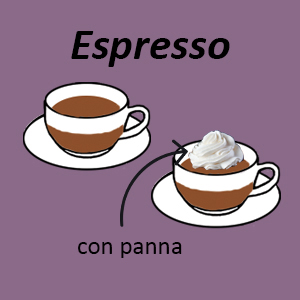
Brewed coffee is fairly straight forward excluding the method of preparation, just take coffee grounds and add water. Focusing on the specialty side of the coffee menu brings us to the foundation of most drinks: Espresso. While it is also made of ground-up coffee beans and water, it yields a thick and syrupy end product. The espresso machine as we know it was patented in 1905 and works by forcing water with high pressure through very finely ground coffee. Each shot is about one ounce and contains around 64 milligrams of caffeine. To put that in perspective, a double shot of espresso (2 ounces) is on par with the caffeine in an 8-ounce cup of brewed coffee.
Originating in Italy, espresso was meant to be drunk standing up, chatting with people at the coffee bar. A single shot is traditionally the standard size with a double shot referred to as a “doppio.” It often comes in a 2-3 ounce ceramic demitasse (small coffee cup) on a saucer. If you spot Espresso con Panna on the menu, it translates to “espresso with cream” and will come as a shot or two of espresso topped with whipped cream.
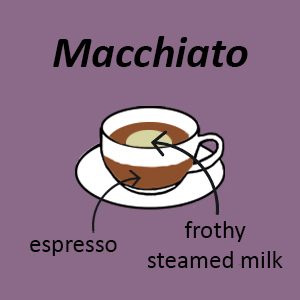
If plain espresso is too rich for you, but you’re not in the mood for a large, milky drink, perhaps you should try a Macchiato. Ordered as a caffè macchiato in Italy, it is espresso “marked” with a bit of frothy, steamed milk. It helps soften the acidic taste but contains more espresso than it does milk. A macchiato also comes in a demitasse, so if you’re expecting something much more milky in a 16-ounce cup with caramel and vanilla, then you are looking for a Starbuck’s Caramel Macchiato.
In the case of this Starbucks staple or more simply, a latte macchiato, it is the inverse of a traditional macchiato. That means that the milk is marked by espresso which is usually added last, creating a layered drink effect. With a large difference between the Italian and American versions, you’ll likely receive a raised eyebrow by the barista when ordering as they try to decipher which beverage you actually want.
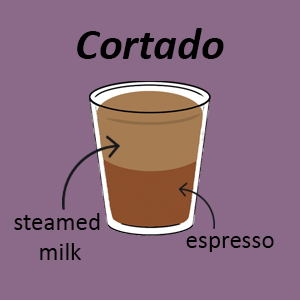
Growing in popularity in recent years is the Cortado. Coming from Spain, this drink is made of espresso “cut” with steamed milk and will likely come in a 4-5 ounce glass. While the macchiato usually has a 2:1 espresso to milk ratio, a cortado comes at either 1:1 or 1:2 depending on where you order it. Another small difference between the two is that the milk in a cortado isn’t traditionally texturized or frothed, just steamed. In some places, you may see it on the menu as a Gibraltar attributing its name to the type of glass it comes in.
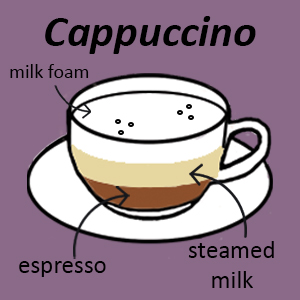
Cappuccino is likely a drink that is a bit more familiar to the general public. Named after the color of robes worn by Capuchin monks, the cappuccino is also made up of espresso and steamed milk. What makes this drink stand apart from the others is the reliance on frothy milk foam. A traditional cappuccino will have equal parts espresso, steamed milk, and foam in a 6-ounce mug. You can order it in a variety of sizes at most chain coffee shops, but that just means it will have more milk and foam, altering the balance of espresso and milk.
While traveling abroad, keep in mind some of the cultural rules that come with indulging in Italian espresso drinks. A cappuccino would never be ordered in the afternoon as it is a breakfast drink best served with a croissant. It is seen as too heavy a drink late in the day so a macchiato is a preferred afternoon pick me up while a plain espresso would be the appropriate after-dinner digestive.
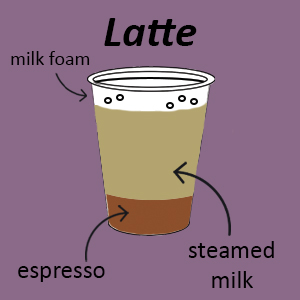
If you order a Latte while in Italy, you will be served a glass of milk. Caffè e latte would be the full name in Italian, meaning milk coffee, but would still give you away as a tourist. The latte was said to have been invented by Lino Meiorin, an Italian-trained barista at Caffe Mediterraneum in Berkley near the University of California. Established in 1957, Caffe Med is one of the oldest coffeehouses in the Bay area and became the meeting place for many activists, artists, and radicals of the ’60s. Lino often got requests for more milk in the cappuccinos, or more “latte”, so he added a larger drink to the menu.
Whether or not that is the true origin of today’s latte, by the ’90s it was made popular in Seattle and spread across the country from there. Now coming in a variety of sizes, espresso and steamed milk is the base for most of the drinks ordered at coffeeshops. It is transformed with added syrups and whipped cream into the tasty treat ordered every day by a majority of our customers.
Another drink that has made it’s way into Western coffee culture is the Flat White. Hailing from either Australia or New Zealand during the ’80s, this drink falls somewhere between a cappuccino and a latte. The difference lies in the process of pulling the espresso and steaming the milk. Typically it would be made with a ristretto shot, espresso made with the same amount of grounds but less water, and mixed uniformly with velvety, steamed whole milk. Warmed to 130 degrees, the milk retains the sweetness and fat that get lost when heated too far. Traditionally a flat white would be served in a 6-ounce tulip-shaped ceramic cup.
Hugh Jackman can be attributed to bringing the flat white to America in 2011 with his Laughing Man coffee shop in New York. Its popularity rose in 2015 when Starbucks added it to their menu.
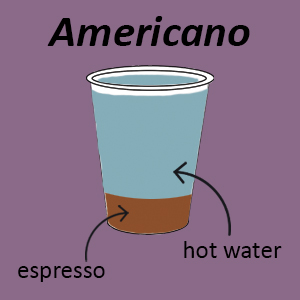
Breaking from this string of drinks made with milk is the Americano, another western invention born out of diluting the strong taste of espresso. Its beginnings were said to have come from American soldiers in Italy during World War II requesting hot water to add to their espresso. The result is essentially the same as brewed coffee, an item that became a staple to survive the long days of war. The basic components are espresso and hot water but it can be made stronger or weaker with the amount of each. At Press Coffee, we only have brewed coffee ready to go before Noon and prepare coffee individually by French Press in the afternoon. An Americano is a comparable substitute for someone in a hurry who can’t wait for slowly-brewed coffee.
As you can see, most drinks on the menu are some assortment of espresso and steamed milk, varying slightly by the amounts of each and steaming techniques. While Starbucks brings the comfort of uniformity among its thousands of shops worldwide, many of their recipes are unique to them while borrowing some of the same Italian terms. Independent coffee shops each specialize in their own ways of making coffee and may cater to the more traditional methods or appeal to the American trends. Either way, this guide should hopefully break down some of the fancy-sounding terms and help you decipher the menu no matter where you show up for your caffeine intake.
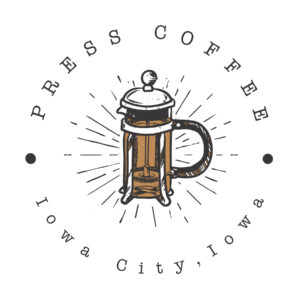
Pressing Newsletter
Social
Find us online:
Facebook
Instagram:
@PressCoffee_ic
@PupsofPress
TikTok
Yelp
Order through the Joe Coffee app!
